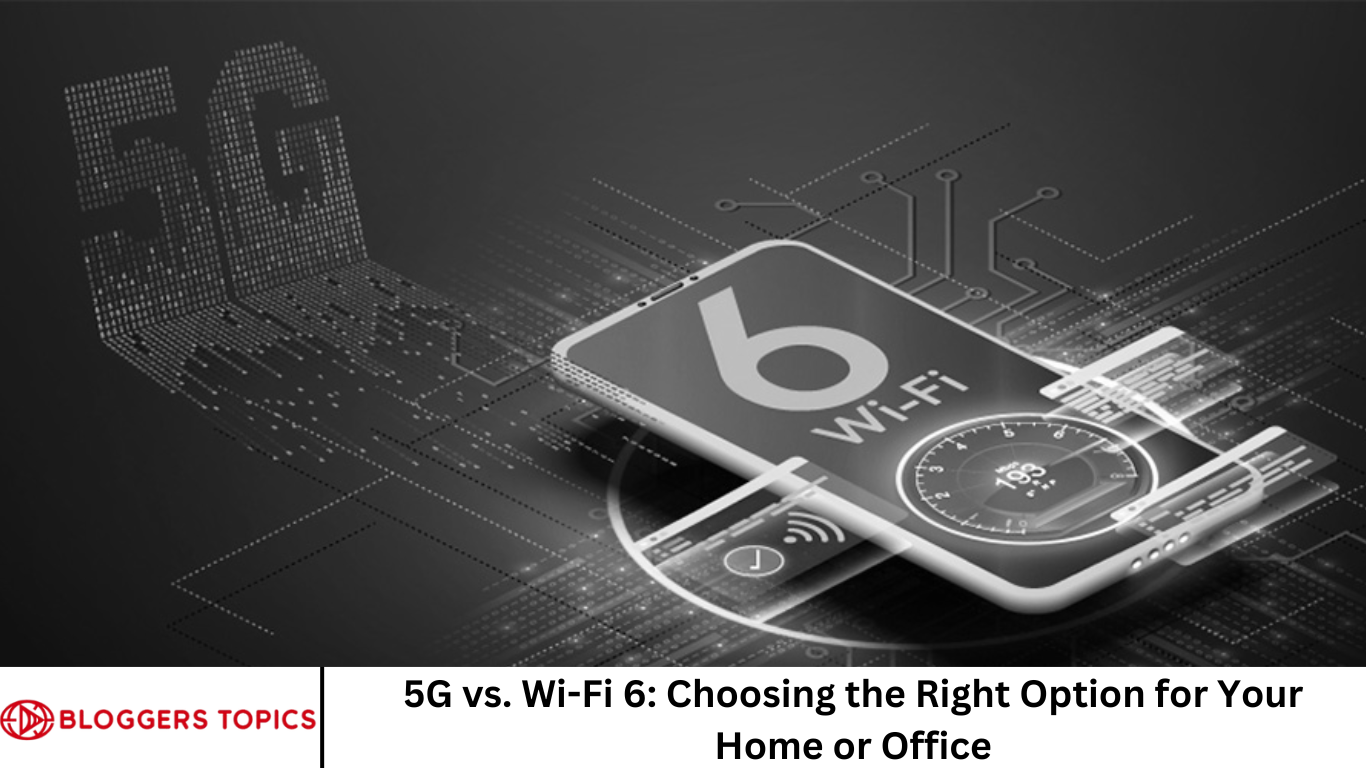The rapid evolution of internet technology is reshaping how we connect, work, and live. Two of the most talked-about innovations in this space are 5G and Wi-Fi 6. Both offer next-generation wireless connectivity with promises of higher speeds, lower latency, and improved device support—but they are built for different environments and use cases.
If you’re wondering whether 5G or Wi-Fi 6 is the better fit for your home network or office environment, you’re not alone. In this article, we’ll break down the key differences, advantages, and limitations of each technology to help you make an informed decision.
More Read: The Ultimate AI Tools of 2025: Automate Smarter, Work Faster
What Is 5G?
5G, or fifth-generation mobile network technology, is the latest advancement in cellular communications. It succeeds 4G LTE and offers significant improvements in speed, latency, and connectivity.
Key Features of 5G:
- Ultra-fast speeds (up to 10 Gbps in ideal conditions)
- Low latency (as low as 1 millisecond)
- High device density support
- Wider coverage using cellular towers
- Mobility for users on the go
5G is primarily offered by mobile carriers and is accessible via smartphones, tablets, and increasingly through 5G home internet solutions.
What Is Wi-Fi 6?
Wi-Fi 6 (also known as 802.11ax) is the latest standard for local wireless networks, designed to improve the performance and efficiency of Wi-Fi in both homes and businesses.
Key Features of Wi-Fi 6:
- Faster speeds (up to 9.6 Gbps)
- Improved performance in crowded environments
- Lower latency
- Better battery life for connected devices
- Backward compatibility with older Wi-Fi devices
Wi-Fi 6 works through routers and access points connected to a broadband modem. It’s ideal for indoor environments where multiple devices are in use.
Speed Comparison: 5G vs. Wi-Fi 6
Both 5G and Wi-Fi 6 offer impressive speed increases over their predecessors. In real-world conditions, however, their performance can vary:
- 5G speeds range from 100 Mbps to over 1 Gbps, depending on the type (low, mid, or mmWave) and signal strength.
- Wi-Fi 6 speeds can reach up to 1-2 Gbps in most homes with modern routers and capable devices.
Winner: Tie – Both offer excellent speeds, but Wi-Fi 6 is more consistent indoors.
Latency: Real-Time Responsiveness
Latency is the delay between sending and receiving data. It’s crucial for real-time applications like video conferencing, gaming, and VR.
- 5G boasts ultra-low latency (~1 ms), especially in mmWave networks.
- Wi-Fi 6 also significantly reduces latency compared to previous Wi-Fi generations.
Winner: 5G – Slight edge due to its design for low-latency mobile applications.
Coverage and Range
Coverage differs significantly between the two:
- 5G networks are deployed through cell towers and cover wide outdoor areas. However, mmWave 5G (the fastest) has limited range and struggles with walls.
- Wi-Fi 6 coverage depends on router placement. It’s excellent indoors but limited to the area around your router.
Winner: Depends on environment – 5G is better for large outdoor coverage, Wi-Fi 6 for consistent indoor coverage.
Reliability and Stability
A reliable internet connection is essential for both work and entertainment.
- Wi-Fi 6, when properly set up, offers a stable, consistent connection.
- 5G may experience fluctuations due to network congestion, weather, or obstructions.
Winner: Wi-Fi 6 – More predictable indoors, especially in office or smart home setups.
Device Density: Handling Multiple Devices
Homes and offices today are filled with connected devices, from smart TVs to laptops and IoT gadgets.
- Wi-Fi 6 supports more devices thanks to technologies like OFDMA and MU-MIMO, improving performance even when dozens of devices are connected.
- 5G is designed for high device density in urban areas but may not be as efficient in small-scale environments like a home.
Winner: Wi-Fi 6 – Superior for handling multiple devices in close quarters.
Mobility and Roaming
If you’re constantly on the move, mobility becomes a deciding factor.
- 5G is designed for mobile use, letting you stay connected while commuting, traveling, or moving between locations.
- Wi-Fi 6 is location-based and loses effectiveness once you’re outside your router’s range.
Winner: 5G – Unmatched for mobile connectivity.
Installation and Setup
Ease of setup can be a major factor for non-tech-savvy users.
- Wi-Fi 6 requires a compatible router and access to broadband service. Once configured, it rarely needs maintenance.
- 5G home internet involves receiving a signal from a cell tower and using a 5G modem/router. Availability depends on your location.
Winner: Wi-Fi 6 – Simpler and more widely available for home use today.
Cost and Availability
Cost is often a deciding factor for consumers and businesses alike.
- Wi-Fi 6 routers are becoming more affordable, and most broadband plans support them.
- 5G plans can be more expensive, and data caps may apply depending on your provider.
Winner: Wi-Fi 6 – More budget-friendly and accessible in most urban and suburban areas.
Security Considerations
As cyber threats rise, robust security is essential.
- Wi-Fi 6 supports WPA3, offering enhanced encryption and security.
- 5G includes advanced network-level security features, but some aspects (like mobile carrier control) may limit user customization.
Winner: Wi-Fi 6 – Slight advantage due to user-controlled security settings and encryption standards.
Use Case Scenarios: Home vs. Office
Best for Home:
- Wi-Fi 6 is ideal for households with multiple users, gamers, streamers, and smart home setups.
- 5G home internet is a great option in areas with poor wired broadband or for temporary setups.
Best for Office:
- Wi-Fi 6 is better suited for internal networks and enterprise control.
- 5G can be useful for remote teams, mobile workers, or as a backup to fiber or cable internet.
Final Verdict: Which Should You Choose?
The choice between 5G and Wi-Fi 6 depends entirely on your specific needs:
- Choose Wi-Fi 6 if you:
- Need fast, reliable internet indoors
- Have many connected devices
- Want full control over your local network
- Prefer lower ongoing costs
- Choose 5G if you:
- Need mobile or temporary internet access
- Live in an area with limited wired broadband options
- Require connectivity while on the move
- Want to use 5G as a backup internet solution
Future Outlook: Can 5G and Wi-Fi 6 Work Together?
Absolutely. The future of connectivity is not about choosing one over the other, but using both in tandem. Many devices are already being built with dual support for 5G and Wi-Fi 6, allowing seamless switching between networks for optimal performance.
For example, a laptop may use Wi-Fi 6 at the office and switch to 5G while commuting. Businesses might use 5G for backup internet while relying on Wi-Fi 6 for internal operations.
Frequently Asked Question
What’s the main difference between 5G and Wi-Fi 6?
5G is a cellular network technology primarily designed for mobile devices and large-scale outdoor coverage. It provides high speeds and low latency for users on the go. Wi-Fi 6, on the other hand, is the latest Wi-Fi standard designed for high-speed, reliable internet within homes or offices. It supports many devices and improves performance in crowded environments.
Which is faster, 5G or Wi-Fi 6?
Both technologies offer high speeds, but Wi-Fi 6 can offer speeds of up to 9.6 Gbps in ideal conditions, while 5G speeds can vary depending on the type of 5G (low-band, mid-band, or mmWave). mmWave 5G can reach speeds of up to 10 Gbps, but its range is limited. In general, Wi-Fi 6 is more reliable indoors, while 5G is faster in optimal outdoor conditions.
Which is better for multiple devices: 5G or Wi-Fi 6?
Wi-Fi 6 is specifically designed to handle many devices at once, using technologies like OFDMA and MU-MIMO to optimize network traffic. It performs especially well in environments with numerous connected devices, such as smart homes or busy offices. 5G can handle many devices, but its performance might be less predictable in a dense, indoor setting.
Can I use 5G and Wi-Fi 6 together?
Yes, you can use both 5G and Wi-Fi 6 in tandem. Many devices today are built to support both technologies. For example, a smartphone can connect to Wi-Fi 6 when indoors and switch to 5G when outside or if Wi-Fi connectivity is unavailable. This flexibility ensures that users can always get the best performance depending on their environment.
Is 5G available everywhere?
No, 5G availability is still rolling out globally. While 5G networks are available in many urban areas, they are not as widespread in rural regions. Availability also depends on the type of 5G (low-band, mid-band, or mmWave) and the infrastructure in your location. Wi-Fi 6, on the other hand, can be used anywhere there is a compatible router and internet connection.
Which is better for gaming and streaming: 5G or Wi-Fi 6?
Wi-Fi 6 is generally better for gaming and streaming within the home or office, as it offers lower latency, stable speeds, and can handle multiple devices without issues. However, if you’re traveling or need mobile connectivity, 5G provides a viable option for on-the-go gaming and streaming, though it may suffer from occasional fluctuations in performance.
Is 5G more expensive than Wi-Fi 6?
5G services are often more expensive, especially when it comes to mobile data plans with limited data or high-speed 5G access. Additionally, 5G home internet plans can also be costlier than traditional broadband options. In comparison, Wi-Fi 6 routers are increasingly affordable, and most broadband plans already support the technology, making it the more cost-effective option for home or office use.
Conclusion
5G and Wi-Fi 6 represent the future of wireless connectivity. While they both offer incredible performance improvements, each shines in different scenarios. For most homes and offices, Wi-Fi 6 remains the more practical and cost-effective solution today. However, 5G is rapidly evolving and becoming a valuable alternative or complement, especially for mobile users and those in underserved areas. Before choosing, consider your environment, usage habits, device types, and future scalability. With the right setup, you may not have to choose—you can harness the best of both worlds.





